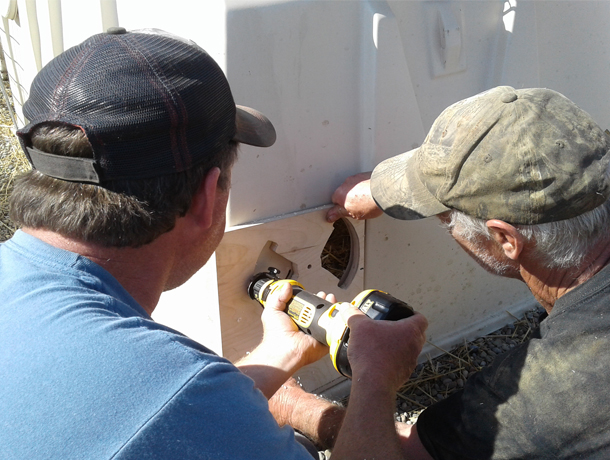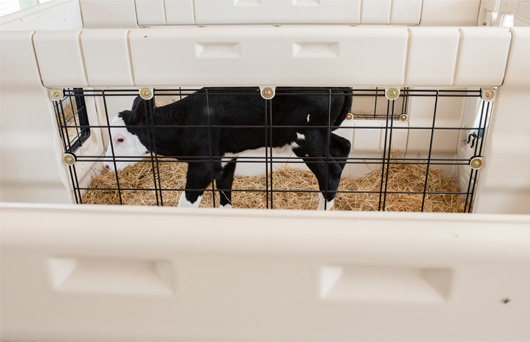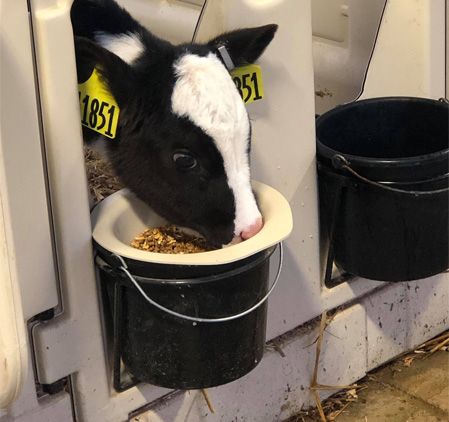The temperature on the thermometer is rising as spring is shifting to summer, causing calf managers to think about ways to minimize heat stress for the animals. Let’s visit about some things we might consider as ways to keep the youngest calves comfortable this season. A calf’s body will naturally attempt to maintain a constant body temperature, regardless of the temperature or weather conditions, within their thermoneutral zone; they can accomplish this without expending extra energy. Often, we think about the thermoneutral zone in conjunction with cold stress and the need for calf jackets or extra energy. However, the hot sun, climbing summer temperatures, and higher humidity can also take a calf out of its thermoneutral zone, increasing maintenance energy needs, reduced feed intakes, and lowered immune systems.
How Hot is Too Hot? When compared to cows, calves seem better able to cope with warmer temperatures. This can be attributed to their larger surface area relative to their body weight and the lower amount of heat generated compared to cows that are digesting fibrous feedstuffs and metabolizing to support high milk production levels. (Penn State) In a study completed by Gebremedhin et al., heat production by calves and water lost through evaporative cooling increased as temperatures approached 75oF, while water lost through respiration increased when temperatures were above 68oF. In another study, calves were exposed to treatment temperatures for seven hours and signs of heat stress were not observed until temperatures neared 90oF with 60% relative humidity (Neuwirth et al., 1979). A 2012 study completed by Bateman et al. suggests calves may not be able to dissipate accumulated heat when daily low temperatures in calf housing exceed 77oF. (Penn State) In all of this it is important to remember that temperature is not the sole indicator. Other factors that can influence heat stress are air movement, moisture, direct sunlight, bedding, rumination, and even hair coat.
Recognize the signs. Calves suffering from heat stress may exhibit any of these important visible signs:
- Faster breathing rate
- Open-mouthed panting
- Reduced movement
- Decreased feed intake
- Increased water consumption
Heat Stress Impacts. In a series of studies conducted by Provimi, data indicated that calves exposed to higher air temperatures (70-80oF) had trouble dissipating heat and were unable to return to their normal body temperature during a 24-hour period. Because cattle pant and sweat to dissipate heat and this increases their maintenance energy requirement, there is less energy from the diet to advance bodyweight gains. Additionally, animals will normally experience a voluntary decrease in feed intake during times of heat stress, reducing the total energy available further. (Bateman)
Research from the University of Arizona concluded that calves in hot conditions had impaired immune systems when compared to calves living in more moderate temperatures. The study measured immunoglobulin concentrations in serum in 2- and 10-day old calves, which could cause an increase in disease for calves in hot conditions. According to Gale Bateman II of Provimi Animal Nutrition, nutritional supplements that assist in maturing the immune system may help these calves, as medium-chain fatty acids have been shown to have antimicrobial and antiviral properties. Short-chain fatty acids and linolenic acid are recognized to stimulate immune function and be anti-inflammatory. By supplementing the diet of calves in hot conditions, the number of disease-causing organisms, like cryptosporidia and rotavirus shedding, should decrease and reduce the incidence of scouring. (Bateman)
Ideas to Help Calves Beat the Heat.
Ventilation. If calves are housed in hutches, be sure to open the vents in the back or retrofit additional vents into your hutches. Calf-Tel provides a hutch vent kit that can be easily added to any style of plastic hutch. In some hot weather climates, calf managers also lift the back of the hutch 4-6 inches to provide more air movement. Some farms have had success mitigating heat stress by installing a shade cloth above the hutches. “In a Missouri study (Spain and Spiers, 1996), 80% shade cloth positioned about 3 feet above plastic hutches reduced the temperature inside the hutch by 4oF.” (Penn State)
If calves are housed in barns or sheds, be sure the facility has plenty of air exchange and ventilation from open curtain walls, fans, or positive pressure ventilation tubes. As the summer temperatures are approaching, now is the time to clean any dust from fans and ventilation tubes to assure proper air movement. Check that all side wall curtains are working properly and that the barn ridge openings are clear of dust and debris. A few minutes of maintenance time can really assure that clean, quality air can move through the facilities as it is designed to.


Lots of clean water. Remember the 1 to 4 rules of water feeding: for each 1 pound of calf starter fed, provide at least 4 pounds (2 quarts) of water. (Leadley) Calves eating calf starter grain require plenty of clean water to efficiently ferment their feed and move their rumen contents into the other stomach compartments. In hot weather, even more water will be needed by calves to help maintain normal body temperatures. Delivering an extra feeding of cool water to any calves without access to free-choice water can really help encourage them to drink more during hot weather.
Feed good, palatable calf starter grains. During hot weather, calf starter grain containers need daily attention. The goal is to keep that fresh grain smell to encourage calves to eat more. Even small amounts of liquid, whether it is milk, water or urine, splashed in the grain can create an environment for mold and hot weather can cause the fats in grain to become rancid. (Leadley) Because calves are very sensitive to smells, keeping grain fresh is key to maintaining intake levels and keeping average daily gains levels on pace. In the hottest days of summer, it has been my experience that calves will tend to eat more during the night when the temperatures are more agreeable for them to be active and moving about. Having enough fresh water and calf starter grain available during the evening hours also will help maintain intake levels.

Bedding. Some calf raisers prefer to use inorganic bedding, such as sand, in warmer temperatures as it absorbs and then dissipates the calf’s body heat, rather than retaining it. Other producers will switch from straw bedding to dried wood shavings or sawdust as the temperatures begin to rise. Regardless of the type of bedding used, it is critical to maintain a clean, dry resting area for calves.
Work Calves in the Morning. The calf’s body temperature and the environmental temperatures are both at the lowest point for the day in the morning. This makes it the optimal time to complete any stressful activities, such as vaccinations, dehorning, and pen moves.
Kelly Driver has been involved in the New York dairy industry all her life. In addition to raising dairy calves and replacement heifers, she is the Northeast Territory Manager for Calf-Tel. Feel free to contact her at kellydriver@hampelcorp.com with your calf questions or suggest a topic you would like covered in a future blog.
Sources
- Bateman, G., II and M. Hill. 2012. How heat stress impacts the growth of dairy calves. Progressive Dairyman. 26:55-57.
- Bentley, Jennifer. (2016, July 3). Baby calves and heat stress. Dairy Herd Management. Retrieved from https://www.dairyherd.com/article/baby-calves-and-…
- Hoskins, Ann. (2019, May 17). Calf care checklist: 5 checkpoints for summer ventilation. Retrieved from https://www.vitaplus.com/blog/articles/calf-care-c…
- Leadley, Dr. Sam. (Internet). Hot weather calf care tips. Retrieved from http://atticacows.com/library/newsletters/HotWeath…
- Pennsylvania State University. (2013, June 14). Heat stress in dairy calves. Retrieved from https://extension.psu.edu/heat-stress-in-dairy-cal…
Courtesy of our dealer – CRI REPRODUCCIÓN ANIMAL MÉXICO SA DE CV.
